Vancouver is known for its abundant natural beauty and wildlife, with birds essential to the city’s ecosystem. From the majestic bald eagle to the vibrant-colored hummingbird, Vancouver has many bird species that thrive in diverse habitats, such as forests, wetlands, and coastal areas.
These birds play a vital role in pollination, seed dispersal, insect control, and maintaining the ecosystem’s overall health.
With its mild climate, Vancouver provides a year-round home or a stopover for migratory birds from as far as Siberia, making it an ideal destination for birdwatchers, wildlife enthusiasts, and eco-tourists.
In this article, we will explore some of the fascinating bird species that call Vancouver their home and the measures taken to protect and conserve them.
13 Birds That Live In Vancouver
Are you a bird lover living in Vancouver or planning to visit it? If so, you are in luck! Vancouver is home to a diverse and rich avian community, with over 400 species of birds recorded in the city and its surrounding areas.
Whether looking for colorful songbirds, majestic raptors, or elegant waterfowl, you will find them in Vancouver’s parks, gardens, wetlands, and shorelines. We will introduce you to 13 of Vancouver’s most common and interesting birds and tell you where and when to spot them.
1. Dark-Eyed Junco
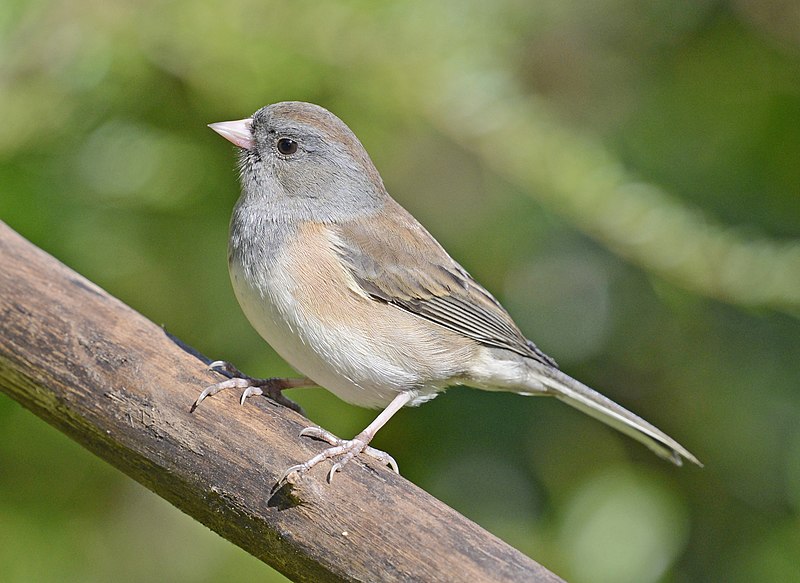
The Dark-eyed Junco is a species of small, grayish sparrows found across much of temperate North America and in the Arctic during summer.
Carl Linnaeus formally described it in 1766 and named it after its distinctive dark eyes.
This bird has a very variable appearance due to the many different subspecies it contains, making its systematics challenging to unravel.
The plumage varies from white or light gray on their underparts with slate grey backs and wings, black heads with white outer tail feathers, brown head stripes, yellow bills, pink legs and feet, and various shades between all these colors.
They also have considerable sexual dimorphism; males tend to be more colorful than females but share similar characteristics such as short tails and rounded bodies – both sexes being around 16 cm long when fully grown.
Scientific classification:
| Kingdom | Animalia |
| Phylum | Chordata |
| Class | Aves |
| Order | Passeriformes |
| Family | Passerellidae |
| Genus | Junco |
| Species | J. hyemalis |
Also Featured In Most Common United States Birds, New Hampshire Birds You Should Know
2. Red-winged blackbird
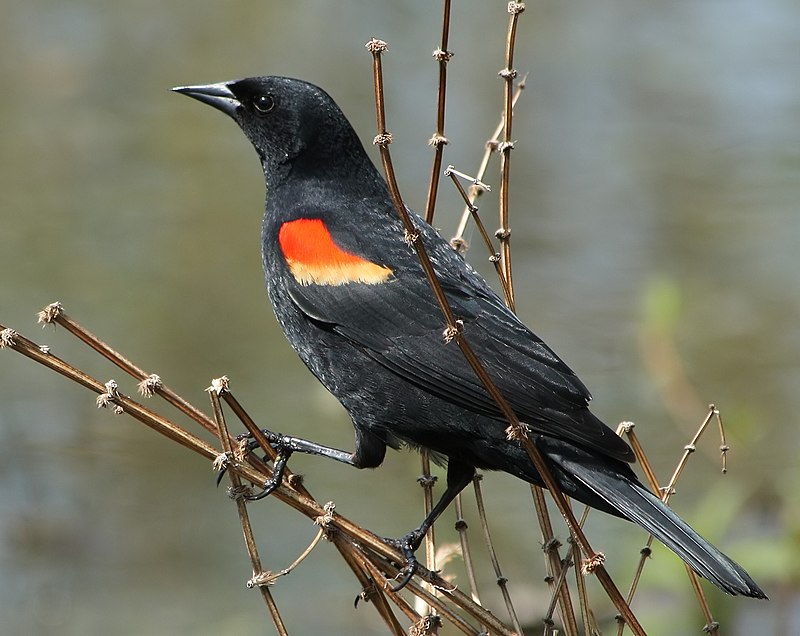
The red-winged blackbird is a beautiful bird found in most of North America and Central America.
Its distinct features include a glossy black body, white shoulder patches, and bright red wing coverts year round.
It prefers wetland habitats such as marshes, ponds, lakeshores, and agricultural fields. During breeding season, they inhabit grassy areas near water, then move south for the winter months.
For food, they mainly eat insects but also consume wild fruit or grains.
They are very social birds, often seen in large flocks during migration when their unmistakable “conk-la-ree” call can be heard echoing across the sky.
Scientific classification:
| Kingdom | Animalia |
| Phylum | Chordata |
| Class | Aves |
| Order | Passeriformes |
| Family | Icteridae |
| Genus | Agelaius |
| Species | A. phoeniceus |
Also Featured In: Flocks Birds Around Us, Birds Commonly Found in Northern California
3. American Coot
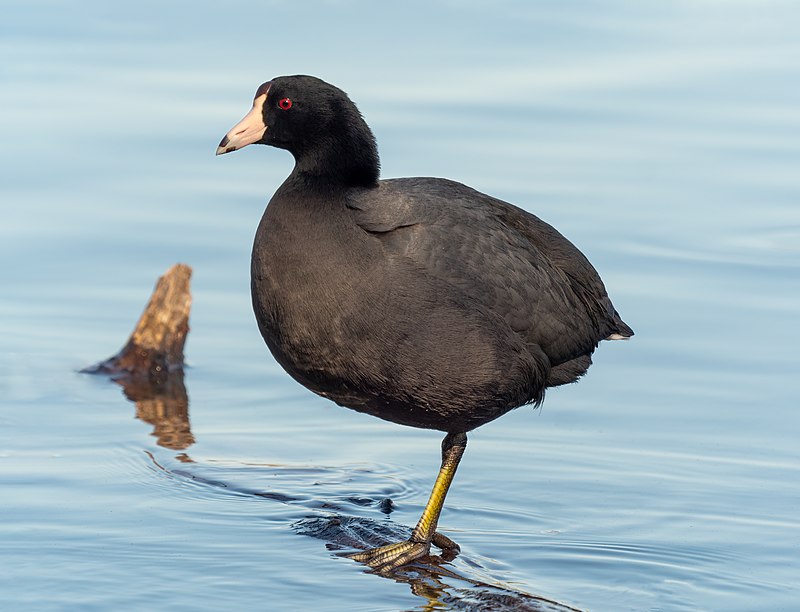
The American coot is a bird of the Rallidae family, commonly mistaken for ducks. However, unlike ducks with webbed feet, they are only distantly related and have broad, lobed scales on their lower legs and toes that fold back with each step to help them walk on dry land.
Coots are omnivores who typically live in freshwater marshes, ponds, and lakes but can also be found in brackish water habitats or open oceans during migration season.
They feed mainly on algae and aquatic plants as well as small fish, snails, insect larvae, and worms from time to time.
The males display territorial behavior by chasing away intruders within their territory, while females mostly lay eggs.
In floating nests made of vegetation near shorelines or islands among reeds, chicks hatch after about three weeks of incubation before swimming off into adulthood at 10-12 weeks old.
Scientific classification:
| Kingdom | Animalia |
| Phylum | Chordata |
| Class | Aves |
| Order | Gruiformes |
| Family | Rallidae |
| Genus | Fulica |
| Species | F. Americana |
Also Featured In Most Popular Bird Species in North America, Phoenix Birds You Should Know
4. Pelagic Cormorant
The pelagic cormorant, also known as Baird’s cormorant or violet-green cormorant, is a small member of the Phalacrocoracidae family and is often referred to as the Pelagic Shag.
It inhabits coastal areas and open oceans throughout Northern Pacific regions. These birds are relatively small in size with dark greyish bodies and bright blue eyes that can be seen from far d
Their wingspan extends up to two feet wide, allowing them to glide through air currents at rapid speeds while they hunt fish for food.
Their impressive diving ability allows them to plunge underwater to reach 30 meters deep.
The pelagic cormorants are pretty social creatures who live together in large flocks during both summer and winter, providing safety in numbers when hunting prey beneath the waves of their ocean home.
Scientific classification:
| Kingdom | Animalia |
| Phylum | Chordata |
| Class | Aves |
| Order | Suliformes |
| Family | Phalacrocoracidae |
| Genus | Uriel |
| Species | U. pelagics |
Also Featured In Native South Korean Birds, Birds You’ll Find in the Sea
5. Great Blue Heron
The Great Blue Heron is a majestic wading bird found in many parts of North America, Central America, the Caribbean, and even as far away as the Galapagos Islands.
It has an impressive wingspan which can reach up to six feet wide. Its feathers are mainly bluish-gray with brownish streaks on its neck and chest, while its head displays white plumes.
The adult herons can also be identified by their yellow bill and legs.
They live near bodies of water such as lakes, marshes, or rivers, feeding on fish using a spear-like motion with their sharp bills.
An all-white population exists only in South Florida and the Florida Keys, making it unique.
Scientific classification:
| Kingdom | Animalia |
| Phylum | Chordata |
| Class | Aves |
| Order | Pelecaniformes |
| Family | Ardeidae |
| Genus | Ardea |
| Species | A. herodias |
Also Featured In Common Birds in Canada, Birds that Live in the Deserts
6. Song Sparrow
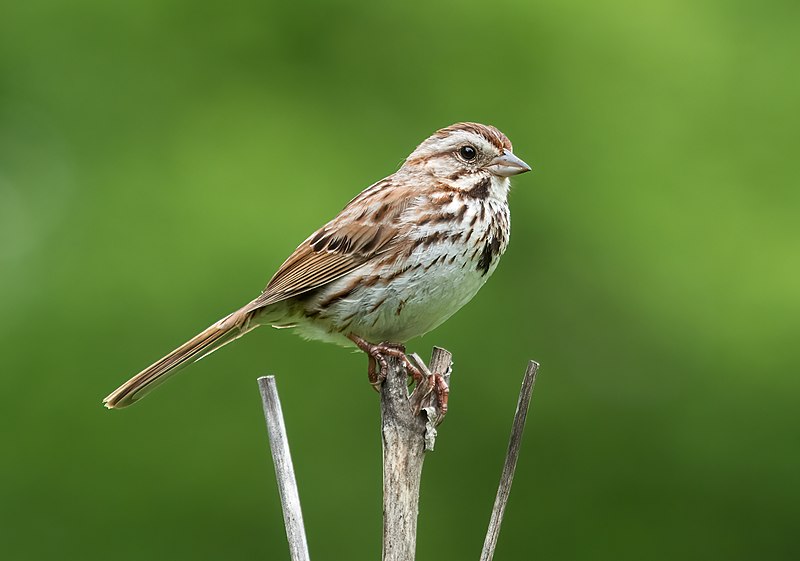
The Song Sparrow (Melospiza melodia) is a small yet abundant bird in North America.
They have brown upperparts with dark streaks and are white underneath, complete with a distinct dark brown spot on the breast.
Their cap is also brown, and long, rough feathers can be seen sprouting from their neck area.
This sparrow species is highly variable and adaptable to many environments, including dry brush land, wetlands, or open fields.
It has been noted that adult song sparrows will sing even during winter when other birds remain quiet.
These energetic little animals make great backyard companions as they sing their lovely melodies.
Scientific classification:
| Kingdom | Animalia |
| Phylum | Chordata |
| Class | Aves |
| Order | Passeriformes |
| Family | Passerellidae |
| Genus | Melospiza |
| Species | M. melodia |
Also Featured In Most Common Songs Birds that Live around You, Birds That Live around Seattle
7. Common Gull
The Common Gull, also known as the Sea Mew, is a medium-sized bird native to northern Europe. It’s closely related to the Short-Billed Gull; both species are sometimes collectively called “Mew Gull.”
During winter, many Common Gulls migrate further south in search of warmer climates.
The exact origin of its vernacular name remains uncertain, but it may have something to do with its call, which resembles a cat meowing.
Its plumage consists mainly of grey and white feathers and black wingtips, making it easily identifiable amongst other gull species.
Scientific classification:
| Kingdom | Animalia |
| Phylum | Chordata |
| Class | Aves |
| Order | Charadriiformes |
| Family | Laridae |
| Genus | Larus |
| Species | L. canus |
Also Featured In Norway Birds, Yellow New Mexican Birds
8. American Bushtit
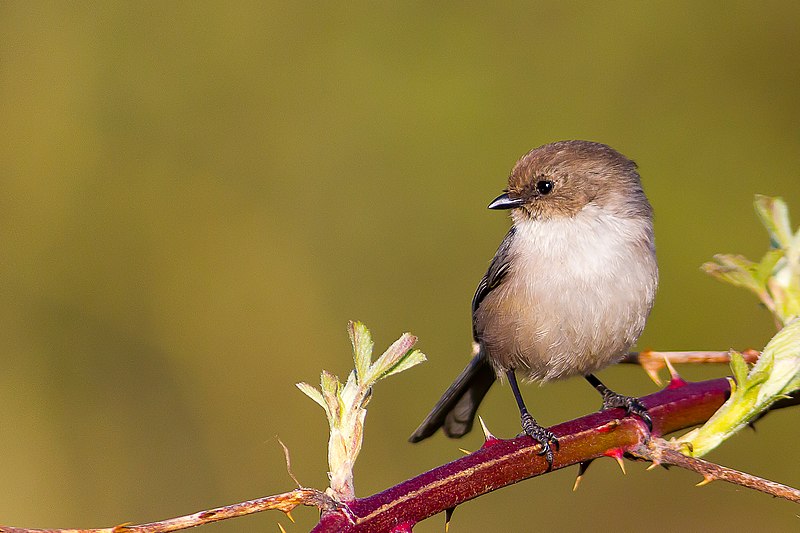
The American bushtit is a small, social bird in the New World. It’s the only species of its genus and family, Psaltriparus minimus.
First described by John Kirk Townsend in 1837, it inhabits forests and coasts from Alaska to Mexico.
Their tiny size (4-5 inches) makes them easily identified by their gray or brown backs with white underparts.
Bushtits have long wings, allowing them to travel quickly between trees; they form flocks that move together through branches looking for food, such as insects, spiders, eggs, and fruit while emitting soft chirps or squeaks.
They build beautiful, large, pendulous nests made of mosses that hang from tree branches high above ground level, where they sleep at night.
These charming birds make delightful company during outdoor activities like hiking or camping.
Scientific classification:
| Kingdom | Animalia |
| Phylum | Chordata |
| Class | Aves |
| Order | Passeriformes |
| Family | Aegithalidae |
| Genus | Psaltriparus Bonaparte, 1850 |
| Species | P. minimus |
Also Featured In: Chickadees Birds, Birds That Live in Colorado
9. Golden-Crowned Kinglet
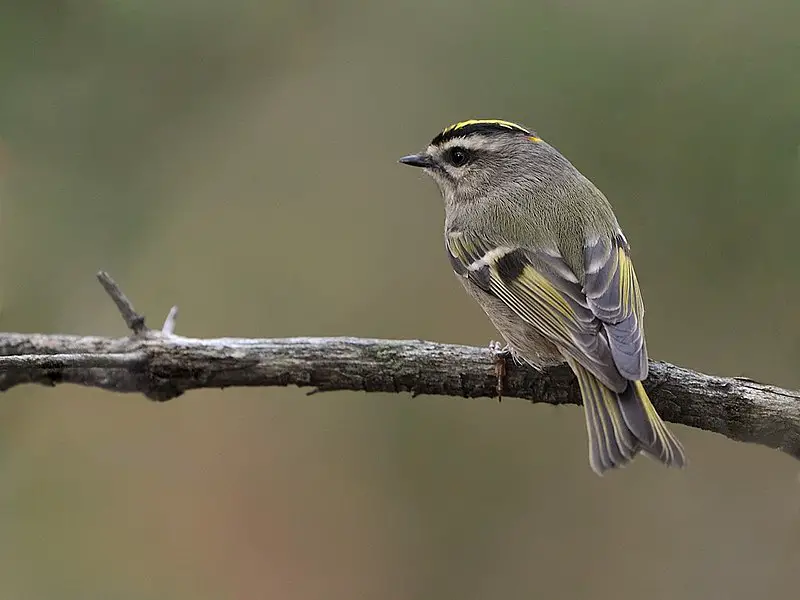
The Golden-crowned Kinglet is a small songbird native to North America. It has an olive-gray top and white underparts, with thin bills and short tails.
The most distinguishing feature of this bird is its yellow crown, surrounded by a black patch that extends through the eyes.
Males have an additional orange patch in the middle of their yellow crowns. They are active birds, often seen flitting from branch to branch as they search for insects or other food sources in trees or shrubs.
During winter, when less insect prey is available, Golden-crowned Kinglets will join mixed-species flocks searching for berries on bushes and trees throughout forests across North America.
Scientific classification:
| Kingdom | Animalia |
| Phylum | Chordata |
| Class | Aves |
| Order | Passeriformes |
| Family | Regular |
| Genus | Regulus |
| Species | R. satrap |
Also Featured In Wrens Species, Most Common Winter Birds
10. Snow Goose
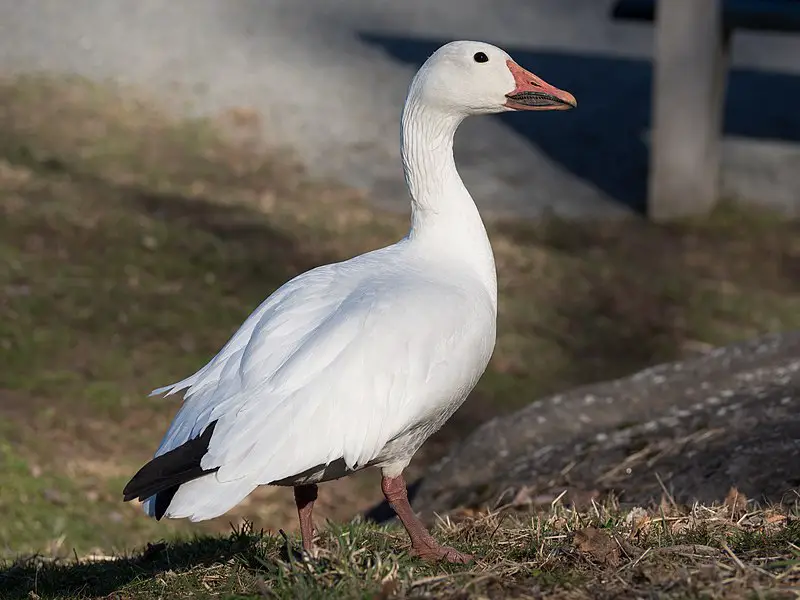
The snow goose is a species native to North America, recognizable by its white or dark plumage. It belongs to the genus Anser, the “gray goose.”
Snow geese breed north of the timberline in Greenland, Canada, and Alaska – places with harsh climates that seem inhospitable for such birds.
Yet they thrive here due to their migration pattern; when winter arrives, they fly southwards along two significant routes towards warmer climates like California and Mexico, where food sources are more plentiful.
Although these graceful waterfowls have adapted well to human activity near some parts of their range, hunting still takes its toll on them, so we must protect this species from extinction.
Scientific classification:
| Kingdom | Animalia |
| Phylum | Chordata |
| Class | Aves |
| Order | Anseriformes |
| Family | Anatidae |
| Genus | Answer |
| Species | A. caerulescens |
Also Featured In Utah Birds, Water Birds Live Around Us
11. Steller’s Jay
Steller’s jay is a beautiful and colorful bird native to western North America and the mountains of Central America.
It has a distinctive long crest sets it apart from other birds, with its blue feathers streaked with black, white, gray, and brown markings.
This species is closely related to the blue jays found in eastern North America but can be distinguished by their longer crests.
They are known for being highly vocal birds who like to make loud calls throughout their forests, steal food from unsuspecting mammals, or raid bird feeders when given the chance.
Steller’s Jays have adapted well to human presence in areas they populate, making them great backyard visitors if you’re lucky enough.
Scientific classification:
| Kingdom | Animalia |
| Phylum | Chordata |
| Class | Aves |
| Order | Passeriformes |
| Family | Corvidae |
| Genus | Cyanocitta |
| Species | C. stelleri |
Also Featured In: Alaska Birds, Blue Birds You’ll Found around Us
12. Clark’s Nutcracker
Clark’s nutcracker is a passerine bird in the Corvidae family, native to western North America. It has two alternate names: Clark’s crow and woodpecker crow.
Its primary food source is pine nuts, which it stores for later retrieval by memory during winter months when other food sources may be scarce.
This omnivore also enjoys eating seeds, fruits, and insects as part of its diet.
The species was first described by Lewis and Clark Expedition members in 1806, who noted that Native Americans used their feathers for ceremonial purposes due to their beauty.
They have distinctive black-and-white patterned wings with grey bodies sporting white underbellies.
They prefer open coniferous forests at higher altitudes where they can build nests on trees or cliffsides using twigs lined with soft materials such as grasses or mosses while taking advantage of natural cavities like stumps or hollows.
Scientific classification:
| Kingdom | Animalia |
| Phylum | Chordata |
| Class | Aves |
| Order | Passeriformes |
| Family | Corvidae |
| Genus | Nucifraga |
| Species | N. Columbiana |
Also Featured in Birds of Wyoming, Lake Tahoe Birds
13. Northern Flicker
The Northern flicker is a woodpecker species found in North America, Central America, Cuba, and the Cayman Islands. This medium-sized bird is known for its unique migration behavior.
Over 100 common names refer to the Northern Flicker, one of them being “yellowhammer.” It is a beautiful bird with distinctive markings and colorful plumage.
The Northern flicker is an essential species in its ecosystem and is crucial in maintaining a healthy environmental balance.
Despite being a woodpecker, the Northern Flicker has a diverse diet, including insects, fruits, and seeds.
Observing this bird as it pecks at trees for food, communicates with its unique vocalizations, and performs its incredible aerial displays is fascinating.
The Northern Flicker is a remarkable bird spaceworthy of our admiration and protection.
Scientific classification:
| Kingdom | Animalia |
| Phylum | Chordata |
| Class | Aves |
| Order | Piciformes |
| Family | Picidae |
| Genus | Colaptes |
| Species | C. auratus |
Also Featured In: Birds Commonly Found in New York, Birds Live in Arkansas
Conclusion
Vancouver is home to a diverse array of bird species, each contributing to the region’s vibrant ecosystem. From the majestic Bald Eagle soaring above to the tiny Anna’s Hummingbird flitting amongst the flowers, these birds captivate residents and visitors alike with their beauty and behavior.
Such a variety of avian life highlights the importance of conservation efforts to preserve their habitats and ensure their continued existence.
By appreciating and protecting these feathered inhabitants, we enrich our natural surroundings and uphold our responsibility to safeguard biodiversity for future generations to enjoy.